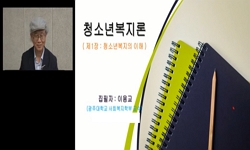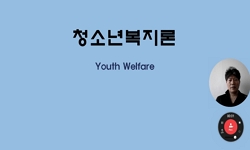Crime and delinquent behavior among adolescents is not a new phenomenon. It has been a long time public concerns. Yet, recently, we encounter growing problems regarding the adolescents delinquent acts in our society. That is, it became more serious, c...
http://chineseinput.net/에서 pinyin(병음)방식으로 중국어를 변환할 수 있습니다.
변환된 중국어를 복사하여 사용하시면 됩니다.
- 中文 을 입력하시려면 zhongwen을 입력하시고 space를누르시면됩니다.
- 北京 을 입력하시려면 beijing을 입력하시고 space를 누르시면 됩니다.
https://www.riss.kr/link?id=A106385861
- 저자
- 발행기관
- 학술지명
- 권호사항
-
발행연도
2019
-
작성언어
English
- 주제어
-
등재정보
KCI등재
-
자료형태
학술저널
- 발행기관 URL
-
수록면
73-88(16쪽)
-
KCI 피인용횟수
0
- 제공처
-
0
상세조회 -
0
다운로드
부가정보
다국어 초록 (Multilingual Abstract)
Crime and delinquent behavior among adolescents is not a new phenomenon. It has been a long time public concerns. Yet, recently, we encounter growing problems regarding the adolescents delinquent acts in our society. That is, it became more serious, cruel, and hazardous. Although there have been a lot of problems implemented to curb youth delinquency, this problems became more serious and cruel. Perhaps, one of reasons explaining the failure of successful implementation of preventive programs for adolescents delinquency is lacking of understanding of important factors for good interventions and programs effective in reducing adolescents delinquency in our society. In conclusion and discussion, this study discussed policy implications and future research suggestions on this topic.
참고문헌 (Reference)
1 Agnew, R, "longitudinal test of social control theory and delinquency" 28 : 126-156, 1991
2 Hood, M. M, "Underage drinking, peer influence, and escalation" 16 (16): 73-87, 1996
3 Akers, R. L, "The techniques of neutralization and violence" 32 : 555-580, 1994
4 Leventhal, T, "The neighborhoods they live in: The effects of neighborhood residence on child and adolescent development" 126 : 309-337, 2000
5 Pratt, T.C, "The empirical statuse of Gottfredson and Hirschi’s general theory of crime: A meta-analysis" 38 : 931-964, 2000
6 Yun, H. M, "The Relationship between Expectation of Alcohol Effects and Alcohol Use among South Korean High School Students" 38 : 153-179, 1999
7 Costello, B. J, "Techniques of neutralization and self-esteem: A critical test of social control and neutralization theory" 21 : 307-330, 2000
8 Gottfredson, G.D, "Standards for program development & evaluation plans" Gottfreson Associates, INC 1999
9 Paulsen, D. J, "Spatial aspects of crime: Theory and practice" Allyn and Bacon 2004
10 Raulsen, DJ, "Spatial aspects of crime: Theory and practice" Pearson.United States 2004
1 Agnew, R, "longitudinal test of social control theory and delinquency" 28 : 126-156, 1991
2 Hood, M. M, "Underage drinking, peer influence, and escalation" 16 (16): 73-87, 1996
3 Akers, R. L, "The techniques of neutralization and violence" 32 : 555-580, 1994
4 Leventhal, T, "The neighborhoods they live in: The effects of neighborhood residence on child and adolescent development" 126 : 309-337, 2000
5 Pratt, T.C, "The empirical statuse of Gottfredson and Hirschi’s general theory of crime: A meta-analysis" 38 : 931-964, 2000
6 Yun, H. M, "The Relationship between Expectation of Alcohol Effects and Alcohol Use among South Korean High School Students" 38 : 153-179, 1999
7 Costello, B. J, "Techniques of neutralization and self-esteem: A critical test of social control and neutralization theory" 21 : 307-330, 2000
8 Gottfredson, G.D, "Standards for program development & evaluation plans" Gottfreson Associates, INC 1999
9 Paulsen, D. J, "Spatial aspects of crime: Theory and practice" Allyn and Bacon 2004
10 Raulsen, DJ, "Spatial aspects of crime: Theory and practice" Pearson.United States 2004
11 Jensen, G. F, "Social learning and the explanation of crime: A guide for the new century" Transaction 39-63, 2003
12 Akers, R. L, "Social learning and social structure: A general theory of crime and deviance" Northeastern University Press 1998
13 Akers, R. L, "Social learning and deviant behavior: A specific test of a general theory (from exploring delinquency: Causes and control" United States 1985
14 Agnew, R, "Social control theory and delinquency: A longitudinal test" 29 : 47-71, 1991
15 Akers, R. L, "Social control theory and delinquency: A longitudinal test" 23 : 47-62, 1985
16 Longshore, D, "Self-control and social bonds: A combined control perspective on deviance" 50 (50): 542-564, 2004
17 Welsh, W. N, "School disorder: The influence of individual, institutional, and community factors" 37 : 73-115, 1999
18 Hawkins, J.D, "Promoting positive adult functioning though social development intentions in childhood: Long-term effects form the Seattle Social Development Project" 159 : 25-31, 2005
19 Coombs, R. H, "Parenting styles and substance use during childhood and adolescence" 50 : 473-482, 1988
20 Bahr, S. J, "Parental and peer influences on the risk of adolescent drug use" 26 : 526-551, 2005
21 Hwang, S, "Parental and peer influences on adolescent drug use in Korea" 1 : 51-69, 2006
22 Crawford, L. A, "Parent-child relations and peer associations as mediators of the family structure-substance use relationship" 29 (29): 155-184, 2008
23 Akers, R.A, "Nothing is as practical as a good theory: Social learning theory and the treatment/prevention of delinquency" Academy of Criminal Justice Sciences 2007
24 Sampson, R. J, "Neighborhoods and violent crime: A multilevel study of collective efficacy" 277 : 918-924, 1997
25 Haynie, D. L, "Neighborhood characteristics, peer networks, and adolescent violence" 22 : 247-169, 2006
26 Shaw, C. R, "Juvenile Delinquency in Urban Areas" University of Chicago Press 1942
27 MBN, "Issue discussion. Atrocity of youth crime and issues relevant with jouverniel crime laws"
28 Yun, Minwoo, "Illicit Drug Use Among South Korean Offenders:Assessing the Generality of Social Learning Theory" 1-22, 2014
29 Yun, Minwoo, "Gendered Pathways to Delinquency: An Examination of General Strain Theory Among South Korean Youth" 12 (12): 268-292, 2014
30 Deng, S, "Family influences on adolescent delinquent behaviors: Applying the social development model to A Chinese sample" 40 (40): 333-344, 2007
31 Dawes, M, "Family and peer correlates of behavioral self-regulation in boys at risk for substance abuse" 25 (25): 219-237, 1999
32 Dillon, F. R, "Exploring the role of parental monitoring of peers on the relationship between family functioning and delinquency" 2008
33 Hawkins, J. D., "Early effects of communities that care on targeted risks and initiation of delinquent behavior and substance use" 43 : 15-22, 2008
34 Booth, A, "Does it take a village?:Community effects on children, adolescents, and families" Lawrence Earlbaum Associates, Inc 2001
35 Yun, M, "Does gender matter in explaining delinquency and suicidal thoughts? An examination of general strain theory in South Korean youths" 2017
36 Jarjoura, G. R, "Does dropping out of school enhance delinquent involvement? Results from a large-scale national probability sample" 31 : 149-171, 1993
37 Akers, R. L, "Deviant behavior; A social learning approach" Wadsworth 1973
38 Akers, R. L, "Deviant behavior: a social learning approach" Wadsworth 1977
39 Mazerolle, P, "Developmental and Life-course Criminological Theories" Routledge 2017
40 Akers, R. L, "Criminological theories: Introduction, evaluation, and application" Oxford University Press 2009
41 Sampson, R.J, "Crime in the making: Pathways and turning points through life" Harvard University Press 2003
42 Hirschi, T, "Control theories of crime and delinquency" Transaction 151-160, 2003
43 Warr, M, "Companions in crime: The social aspects of criminal conduct" Cambridge University Press 2000
44 Messner, S. F, "Class, compliance structures and delinquency:Assessing integrated structural-Marxist theory" 96 : 300-328, 1990
45 Hirschi, T, "Causes of delinquency" Free Prees 1969
46 Yun, M, "A Test of an Integrative Model Using Social Factors and Personality Traits: Prediction on the Delinquency of South Korean Youth" 1-26, 2016
47 Kim, E, "A Cross Cultural Test of Social Structure and Social Learning: Alcohol Use among South Korean Adolescents" 34 (34): 895-915, 2013
48 Kim, E, "A Cross Cultural Test of Social Structure and Social Learning: Alcohol Use among South Korean Adolescents" 34 (34): 895-915, 2013
49 AP, "2019 youth report. The number of adolescent dellinquents were declined, but their crime became serious"
동일학술지(권/호) 다른 논문
-
- 한국범죄심리학회
- 이진
- 2019
- KCI등재
-
- 한국범죄심리학회
- 이성대
- 2019
- KCI등재
-
제4차 산업혁명 시대의 드론 이용 테러리즘의 실태분석 및 대응방안
- 한국범죄심리학회
- 임창호
- 2019
- KCI등재
-
비행청소년의 심리사회적요인과 사이버언어폭력에 관한 연구
- 한국범죄심리학회
- 윤성희
- 2019
- KCI등재
분석정보
인용정보 인용지수 설명보기
학술지 이력
| 연월일 | 이력구분 | 이력상세 | 등재구분 |
|---|---|---|---|
| 2022 | 평가예정 | 재인증평가 신청대상 (재인증) | |
| 2019-01-01 | 평가 | 등재학술지 유지 (계속평가) |  |
| 2016-01-01 | 평가 | 등재학술지 선정 (계속평가) |  |
| 2015-01-01 | 평가 | 등재후보학술지 유지 (계속평가) |  |
| 2014-01-01 | 평가 | 등재후보학술지 유지 (계속평가) |  |
| 2013-01-01 | 평가 | 등재후보 1차 PASS (등재후보1차) |  |
| 2012-01-01 | 평가 | 등재후보학술지 유지 (기타) |  |
| 2011-01-01 | 평가 | 등재후보 1차 PASS (등재후보1차) |  |
| 2009-01-01 | 평가 | 등재후보학술지 선정 (신규평가) |  |
학술지 인용정보
| 기준연도 | WOS-KCI 통합IF(2년) | KCIF(2년) | KCIF(3년) |
|---|---|---|---|
| 2016 | 0.95 | 0.95 | 1.14 |
| KCIF(4년) | KCIF(5년) | 중심성지수(3년) | 즉시성지수 |
| 1.1 | 1.05 | 1.468 | 0.06 |




 KCI
KCI






